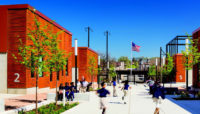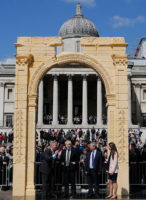“It is much better to be good than to be original,” Ludwig Mies van der Rohe famously advised his protégé Philip Johnson.
That’s the rationale of a faction of Mies enthusiasts who want to reconstruct a forgotten but seminal work of the architect’s, now buried beneath a park in Poland. Called the Wolf House, it is Mies’s first built modernist house.
Supporters of the project hope to rebuild the structure as a museum to experience Mies’s genius. “The reconstruction is an important visual and physical aid to understand the architecture,” asserts Florian Mausbach, a retired German planner spearheading the efforts. Advocates of the proposal hope to break ground by 2019 to mark the Bauhaus’s centennial.
But the campaign has sparked ideological debate among historians who believe the house cannot be reconstructed economically and authentically. “All you would get is a very abstract rendering of what the Wolf House may or may not have been,” says Leo Schmidt, a professor at Brandenburg University of Technology. “It seems completely artificial.”
In 1925, Erich Wolf, a well-to-do German cloth manufacturer and art collector, approached Mies to design a house for his family on the site of a former vineyard. The result was a sprawling modernist brick villa—a dramatic interplay of volumes and terraced gardens.
“The Wolf House is the very first work in which Mies developed the idea not of the open plan, but a plan of sliding spaces,” says Barry Bergdoll, who organized the 2001 MoMA exhibition Mies in Berlin during his tenure there as the Philip Johnson Chief Curator.
So prominent was the Wolf House in the town, the villa even appeared on its tourism literature.
After WWII, the German-Polish border was redrawn along the Neisse River, and the town was split. Germans were expelled from the Polish side, and the Wolf House was destroyed, its bricks carted away to rebuild Warsaw.
The house was lifted out of obscurity by the Mies in Berlin exhibition and an excavation by Schmidt and his students the same year. They unearthed the basement and shards of the Wolfs’ china collection.
In 2013, Mausbach launched a campaign to reconstruct the masterwork. The blueprints for the house are lost, but he enlisted a group of researchers at the University of Potsdam to remake the plans, relying on drawings in the MoMA collection and family photographs.
“The notion is to make it possible to experience the spaces,” says Dietrich Neumann, a professor of architecture at Brown University who is partnering with Mausbach. In Neumann’s estimation, the Wolf House could be constructed even more accurately than Mies’s 1929 German national pavilion in Barcelona, rebuilt in 1986 to critical acclaim. “We know the ceiling heights and the layout of the floor,” he says. “There might be corners where you have to make a guess, but I don’t think it detracts from the advantage of experiencing the space.”
But Bergdoll calls the whole initiative “crackpot” and points out that the Barcelona pavilion was meant to accommodate vast numbers of people moving through it. Furthermore, “Many of the interesting perceptions about the pavilion that came from reconstruction had to do with polished materials—you were to experience it phenomenologically. I don’t see how that’s going to happen in a white plaster box.”
"They will never create the building,” he says. “All they can do is create a simulacrum of the spatial sequences.”
Proponents of the reconstruction believe that a new Wolf House could promote cultural understanding and generate tourism for the hardscrabble towns on either side of the river. Officials on both the German and Polish sides have greeted the endeavor with open arms.
Schmidt finds such an approach problematic. “The Wolf House’s significance is not primarily because it was designed by a famous architect but because it’s an archaeological site of the 20th century and the horrors in that part [of Europe],” he says. “Its emotional content is an important factor in the significance of the place.” Instead, he and his students proposed a dozen alternatives to a complete reconstruction.
At the moment, the crucial barrier to reconstruction is funding. In Mausbach’s estimation, the project will cost approximately 2 million euros. He has recruited the support of an advisory board including patrons Phyllis Lambert and Lord Peter Palumbo, and architect Helmut Jahn, and is seeking the financial support of private backers and European govern- ment grants. With Neumann, he intends to drum up awareness with a traveling exhibition which they hope could be shown at the Illinois Institute of Technology. With the aid of the Potsdam team and archaeologists, he hopes to embark on a separate excavation in 2017.
“The Harvard philosopher Nelson Goodman said there is art that can be faked—like a sculpture or a painting—and art that can be played again and again, like a piece of music, a play, or a book that’s been reprinted,” says Neumann. “I would claim to a certain degree with architecture, it’s like having a score from which you work.”






